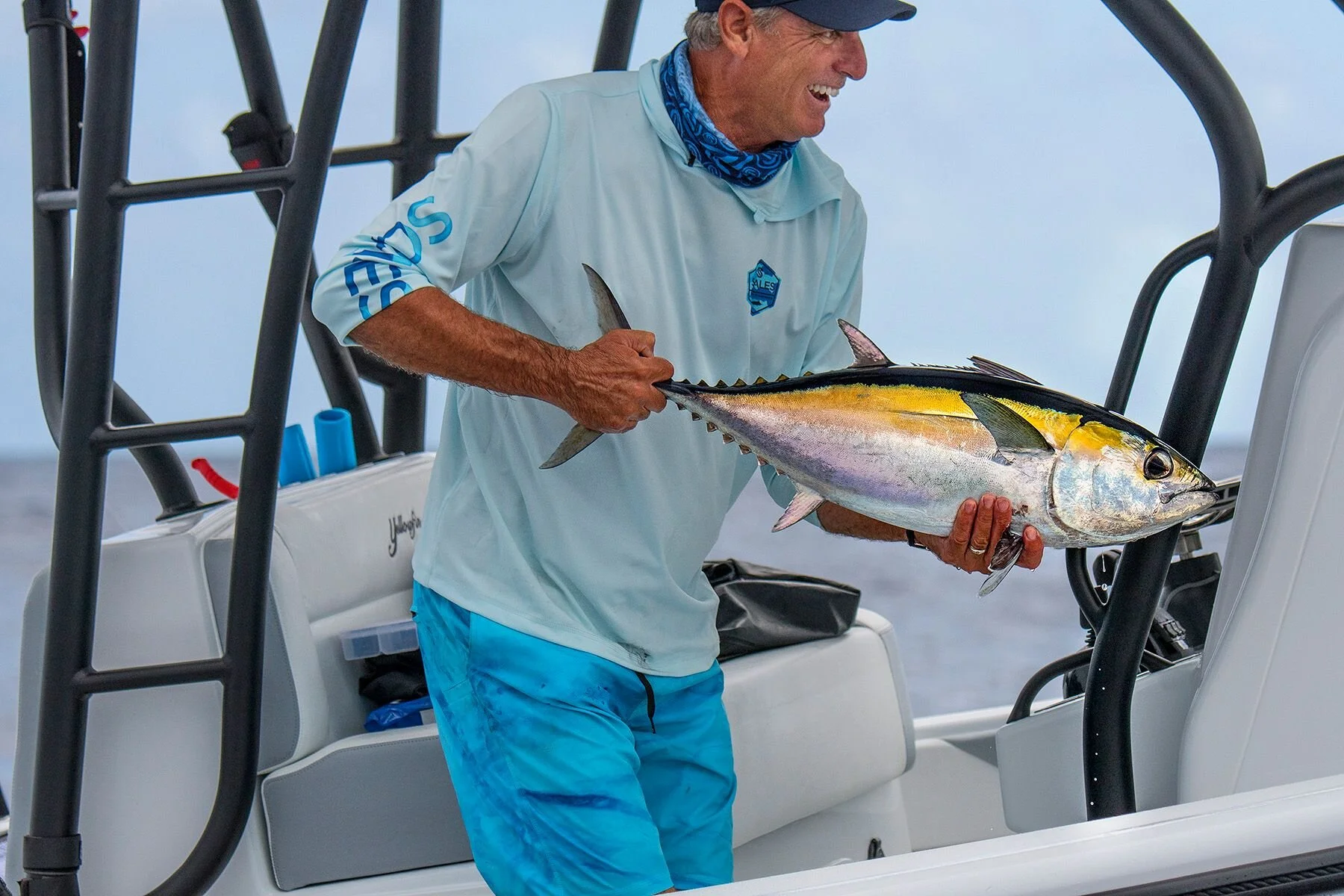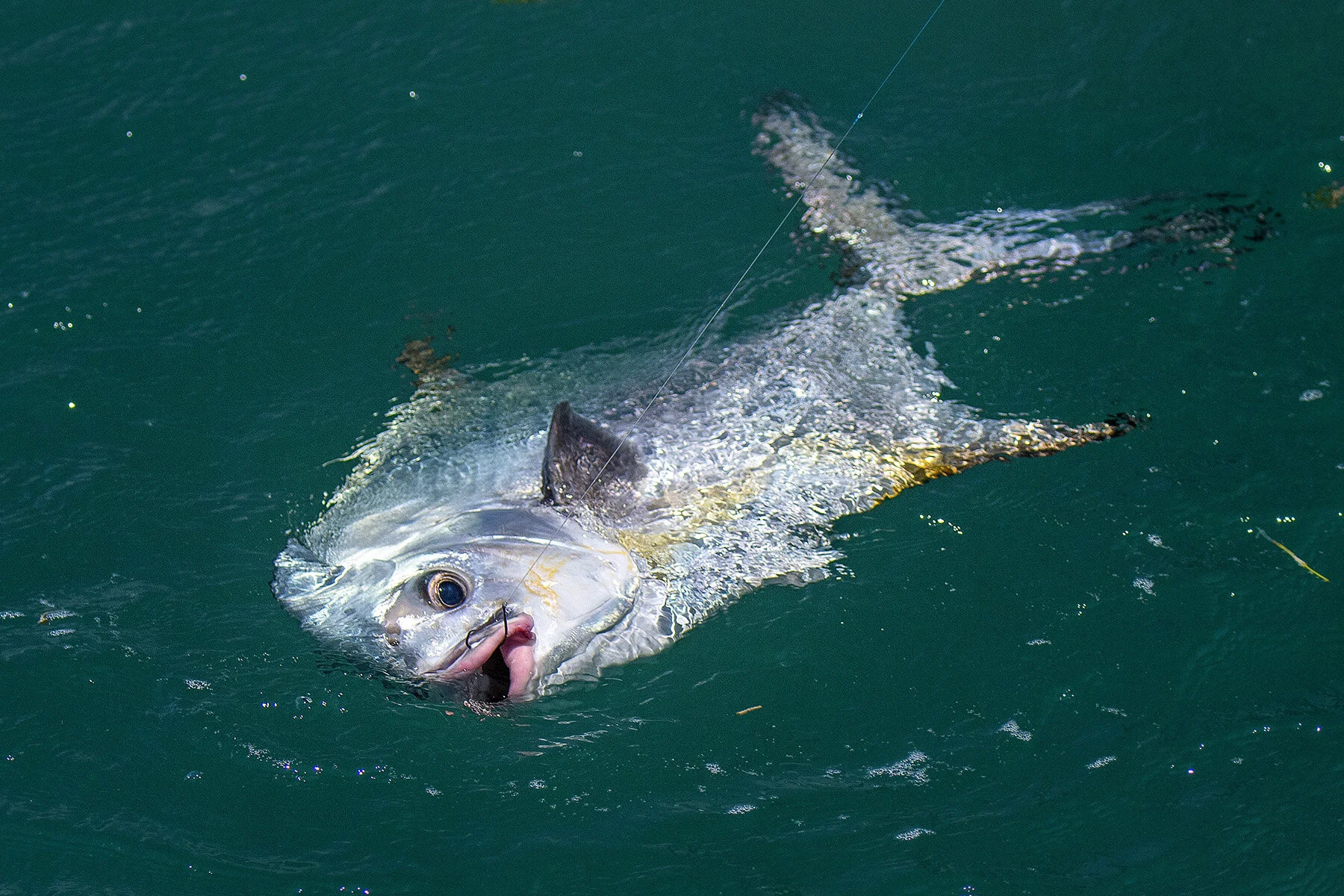Proper Etiquette Around Other Boats (Plus Some Tuna Tips)
written by Evan Anderson
In this episode of Into the Blue, captains Scott Walker and Steve Rodger try a more popular fishing hole, a well-known submarine wreck, in hopes of finally getting a big haul of blackfin tuna. “One of the most famous wrecks down here is the submarine wreck,” says Rodger, “It’s what I built my career around fishing down there, whether I was right on top of it or just inshore of it. But it’s always crowded, it’s a great spot.” It’s a satisfying day on the sea after their last couple outings were dogged by sharks. We’ll take a look at some of their advice for catching tuna as well as proper etiquette around other boats on a crowded day.
Keep Your Bait Fresh
As Walker and Rodger exit the beautiful Oceans Edge Resort marina, they hop up onto the slip-free Seadek on the bow to toss their nets into the shallow water, swiping up schools of pilchards. They’ll need as much live bait as they can get for where they’re going. “The number one thing is you’ve gotta have bait,” says Rodger. Because of the popularity of this particular fishing spot, the school of tuna residing around the wreck has been trained by fishermen constantly using live bait. So artificial lures won’t cut it for a spot like this. “These fish are trained up to eat that bait,” Rodger continues as he tosses another net, “they’re there because the guys are there throwing bait...7 days a week.” If you’re unsure about the habits of the fish in a regular spot like this, talk to someone who has fished it before to see what you should bring. If it’s as popular as the submarine wreck, you shouldn’t have much trouble finding someone with experience.
“The number one thing is you’ve gotta have [live] bait.”
The next thing to note about your live bait is that it’s got to be fresh. It’s got to be active. Tuna are an aggressive fish and are more likely to go after bait that is active. As Walker explains, “They’ve seen everything. they’ve seen 20 lb leader, 30 lb leader, they’ve seen hooks, they’ve seen pilchards, and they want to chase these things.” He dumps another net full of bait into the well. Walker advocates maintaining your bait well and keeping it clean to accomplish this. “Make sure the pumps are perfect, make sure the flow is perfect, all those little things that people don’t think about,” he says, “You gotta let water in, let water out, overflow the tank so they don’t get beat up on the run; so that when we get there we have the freshest bait possible to get these fish really jacked up.”
@ SE Multimedia 2019
Stay Out Of The Way
As Rodger’s boat cruises into position, its Mercury Marine motor rumbling, their prediction of a popular spot isn’t too far off. While there isn’t a huge crowd of boats anchored up like there normally may be, there’s still a decent group of them braving the rough surf to get in on the action. “I waited for a real rough day so we kind of have it to ourselves,” says Rodger, “It makes it a little bit easier because...we have camera boats, we have a diver, we have a still guy, we have a drone, we have a big production deal. So it’s kind of intrusive and it’s my backyard, and I like to try and stay out of the way of the guys who are working.”
Commercial fishing guides make their living by their clients catching fish. If you get too close, you can spook the fish away from their boat or even get someone’s line tangled up in yours. If that happens, may God have mercy on your soul because the odds are you won’t be on this earth much longer. The wrath of even a moderately salty sea captain is truly an awesome sight to behold.
Be Careful When Drifting
One tactic many captains use is drifting. That is, if they can’t quite get the fish active in the spot they are anchored in, they’ll pull up and drift with the current, keeping their lines in the water. This is a fine strategy if you have some place all to yourself. But in a crowded environment like the submarine wreck where there could be a half-dozen to a dozen boats there on an average day, according to Rodger, drifting is a big no-no. Rodger explains, “You don’t want to drift unless everybody’s drifting. If you go down there and you see people anchored up, you need to either anchor up or you need to stay way out on the outside.”
Rodger also adds that if you do decide to drift, don’t continue to throw chum or scoops of bait into the water as that will draw the school of fish away from all the other boats that are anchored up over the wreck. “You’ve taken a little piece of the school every time,” says Rodger, “and it makes the fishing tougher [for everyone else].” In this situation, Rodger found that, because it wasn’t too crowded that day and the conditions were right, drifting seemed to be an appropriate choice. So, to keep from drawing the fish away from the wreck, they made sure to throw one scoop of bait into the water right over the wreck, and drift from that spot. Then they’d fire up the Mercury and drive back to the wreck. “We put out a couple flatlines,” says Rodger, “And as soon as we had our position right, we were right over top of the wreck, we would throw a scoop and the tunas would bust, and we actually were able to get a bite.”
@ SE Multimedia 2019
Rodger’s and Walker’s etiquette kept them from having any conflicts with other boats over the wreck while still allowing them to catch a decent haul of blackfin tuna. Follow their example the next time you’re in a crowded spot. The extra couple fish you MIGHT catch are not worth getting in everyone else’s way. Check out the full episode below and see how they handled the crowd on S11:E11 of Into the Blue.



















